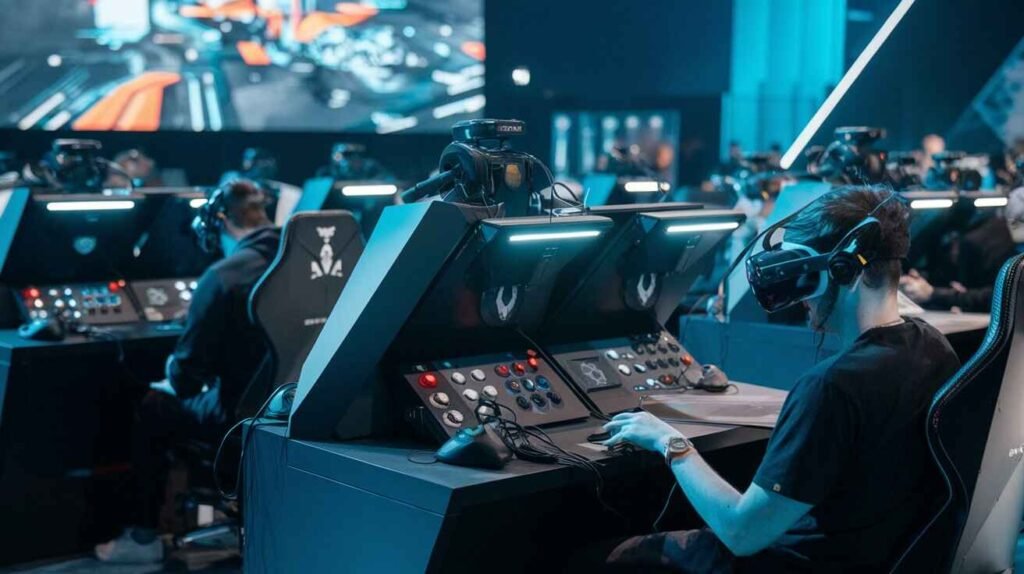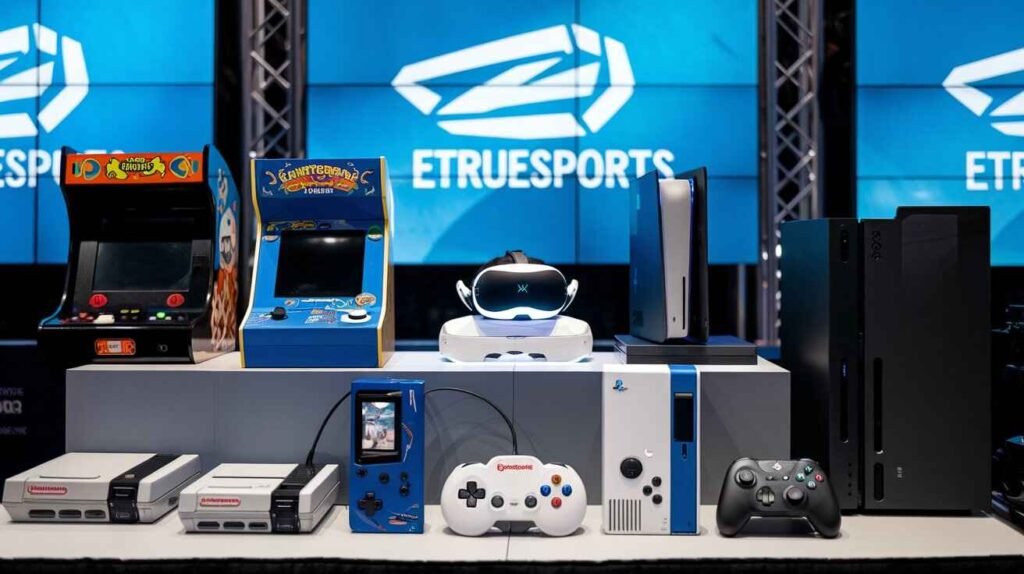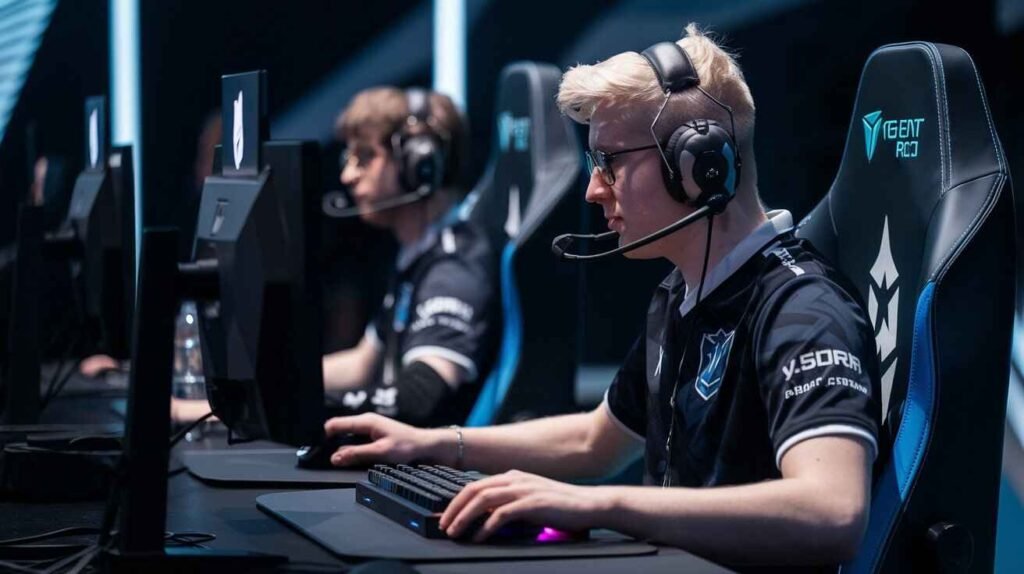Introduction to Tech Etruesports
In recent years, eSports has evolved from a spot hobby into a booming international industry. What makes this boom even more thrilling is the combination of eras. “Tech Etruesports” refers to the technological improvements that have turned competitive gaming into a huge phenomenon. From cutting-edge gaming hardware to superior software structures, tech has performed a critical function in shaping the esports landscape. For example, improvements in cloud computing technologies have transformed how games are streamed and played on various platforms, which can be explored more in this guide on what is deep offshore technology.
This article will explore Tech Etruesports’ upward thrust, detailing its history and key technological components and their impact on each gaming tradition and the financial system. Whether you’re new to the world of competitive gaming or have been following the scene for years, this guide will help you understand how the generation is using the destiny of eSports.
What is Tech Etruesports?
Tech eSports refers to the intersection of technology and eSports. It consists of improvements in hardware (like gaming PCs, consoles, and peripherals), software (including sports engines and streaming platforms), and internet connectivity (including low-latency networks). These advancements permit players to compete in high-stakes tournaments while offering fans a global-class viewing experience. The role of low-latency networks is key in making eSports smooth and competitive; for those interested in resolving connection issues, our guide on fixing error code 520 might be useful.
In its middle, Tech eSports shows how the era has evolved to satisfy competitive gaming needs. While conventional sports activities are based on physical talents, eSports is driven by virtual equipment, online platforms, and effective gaming generation.
Key Features of Tech Etruesports
- eSports vs. Traditional Sports: Unlike traditional sports activities, which depend on physical abilities and patience, eSports competitions are era-pushed. Players use excessive-performance gaming structures to execute particular strategies, requiring excessive mental focus and teamwork. Tech Etruesports lets gamers compete globally without the limitations of bodily distance.
- Tech Innovations: Tech innovations have reshaped the global eSports industry. These range from gaming computers with extremely fast processors and graphics cards to the rise of streaming structures like Twitch and YouTube, which permit thousands of visitors to watch live events from around the globe. These technological improvements continue to push the boundaries of what’s possible in eSports.
Historical Context and Evolution
Origins of eSports
eSports, as we know it today, began in the early 2000s. Initially, it changed into small-scale LAN (Local Area Network) events in which game enthusiasts might come together to compete. These casual events quickly gained traction, with the first major tournaments being held for famous games like Quake and StarCraft. These early competitions showcased the capability of aggressive gaming and laid the foundation for large events.
Over time, the upward push of online platforms like Battle.net allowed game enthusiasts from everywhere in the world to compete without needing to be in the same physical region. The first big eSports tournaments helped to set up a competitive environment that could only grow in the coming years.
Technological Advancements Over Time
In the late 2000s, streaming platforms became essential in the eSports landscape. For instance, Twitch rose to prominence as a hub for live eSports broadcasts. To delve deeper into how technologies have been shaping the future, understanding disruptive tech, like in this article about disruptive technologies, is key to seeing where eSports is headed.
- Early 2000s: During this period, ESports were socially constructed around LAN tournaments. The technology of the time restrained the size of those occasions. However, games like StarCraft and Quake helped set the groundwork for a growing aggressive scene.
- Late 2000s to 2010s: This era marked the upward push of streaming structures, with Twitch becoming a primary hub for eSports announcements. Platforms like YouTube Gaming additionally contributed to the increase of competitive gaming as a spectator sport. With progressed internet speeds and the growth of platforms that allow visitors to look at live events, eSports has become more than just an interest; it has become a worldwide amusement enterprise.
- Technological Milestones: The speedy advancement of gaming hardware in this era became a game-changer. Powerful GPUs, faster processors, and upgrades in gaming consoles made it feasible to run video games with better photographs and smoother gameplay. This also improved immersive game reviews, enhancing each participant’s overall performance and spectator entertainment.
Key Milestones Inside the Development of Tech Etruesports
- The Rise of Global Organizations: As eSports grew in reputation, major teams and corporations began to emerge. Teams like Team Liquid and Cloud9 won an international reputation. These teams regularly partnered with fundamental tech corporations, such as Intel, NVIDIA, and Razer, for sponsorships, contributing to the developing industry.
- Expansion into Mainstream Media: eSports’ transformation from a spot interest to a mainstream spectacle was supported via partnerships with television networks and main sports channels. In a few cases, esports competitions have even been considered for inclusion in the Olympic Games, signaling the growing popularity of aggressive gaming as a valid game.
- Major Tournaments and Sponsorship Deals: eSports tournaments, including the League of Legends World Championship and The International (Dota 2), became annual events, attracting thousands of visitors. High-profile brands, including Coca-Cola, Mercedes-Benz, and Samsung, signed sponsorship deals, further expanding the enterprise.

Importance in Modern Society
Cultural and Economic Impact
eSports is reshaping international pop culture. What became once visible as a gap hobby has come to be a multi-billion-dollar industry with a wide global fan base. In fact, the rise of mobile gaming has expanded the audience, with mobile platforms becoming central to gaming growth. Those curious about mobile network choices could consider reading Mingle vs. Boost Mobile to explore options that enhance gaming experiences on the go.
Gaming communities now amplify beyond the players, with fanatics engaging with content creators, streamers, and expert gamers online. Integrating eSports into enjoyment activities and social media has cemented its place within the modern-day cultural landscape.
Global Economic Reach
eSports isn’t just about gambling video games—it’s a thriving business. Sponsorships, advertising, product sales, price tag income for live activities, and broadcasting rights contribute to the industry’s economic growth. The eSports economy continues to expand, with projections indicating that worldwide revenue will surpass $1.5 billion by 2025.
Social Impacts
- Building Global Communities: eSports has allowed gamers from all corners of the sector to attach, interact, and shape groups. Fans share content material, talk strategies, and help their favorite gamers, creating a feeling of belonging and camaraderie.
- Youth Engagement and Skill Building: Many schools now have eSports packages, coaching students on teamwork, strategic thinking, and technical abilities. These applications provide a route for students to show their passion for gaming into professional opportunities.
The Technology Behind Tech Etruesports
Hardware Innovations
- Gaming PCs and Consoles: Players want modern gaming hardware to compete at the highest level. High-performance gaming PCs are geared up with top-tier GPUs (Graphics Processing Units), CPUs (Central Processing Units), and RAM to handle the annoying desires of aggressive video games. Gaming hardware, including GPUs, continues to evolve rapidly, with brands like Nvidia playing a huge role in shaping the industry. For insights into the broader hardware landscape, you might find this article on how to find the IMSI of your Android phone an interesting read about hardware details. Some players also select custom-built structures, allowing them to produce high-quality music on their PCs for the highest overall performance.
- Gaming Peripherals: Using specialized gaming peripherals like high-precision mice, keyboards, and controllers is vital in competitive play. These gear provide low-latency inputs, assisting gamers to respond faster and more correctly at some stage in crucial moments. Additionally, headsets with three-D audio and noise cancellation make certain clean verbal exchanges, particularly in crew-based games.
- Ergonomics: Competitive gaming requires long hours of play. As such, ergonomically designed gaming chairs, desks, and other add-ons have become increasingly popular. These merchandise help gamers preserve comfort and avoid strain during lengthy gaming periods.
Software and Platforms
- Game Engines: Unreal Engine and Unity are the most famous sports engines with modern-day eSports titles. These engines provide the underlying framework for developing immersive, excellent games that run easily on various structures, ensuring players and visitors enjoy the table the most.
- Cloud Genjoyment: Services like Google Stadia and NVIDIA GeForce Now have added cloud gaming, allowing gamers to enter excessive-quit video games without expensive hardware. This technology opens up eSports to a broader target audience, permitting everybody with a web connection to compete in expert-level tournaments.
- Streaming Platforms: The upward push of systems like Twitch, YouTube Gaming, and Facebook Gaming has played an important role in the worldwide growth of eSports. These structures allow thousands of lovers to watch live broadcasts of eSports activities, interact with streamers, or even become part of the aggressive scene themselves.
Major Players in the Tech Etruesports Industry
Leading Companies
- Tech Giants: Companies like Intel, NVIDIA, and AMD supply the hardware wanted for aggressive gaming. Microsoft and Razer also play considerable roles in providing remarkable gaming peripherals and systems.
- Streaming Services: Twitch has become the go-to platform for eSports content. At the same time, YouTube and Facebook are essential players in the industry. These systems provide the infrastructure for eSports proclaims, providing actual-time stats, observation, and fan interplay.
- Game Developers: Leading businesses like Riot Games, Valve, and Activision Blizzard hold to increase the video games that dominate the eSports scene. Titles like League of Legends, Dota 2, and Call of Duty have become family names in the aggressive gaming international.
Sponsorships and Investments
As eSports grows, leading brands increasingly invest in sponsorship offers and classified ads. This financial backing is vital for the industry’s sustainability and further expansion.
Popular Games and Genres
eSports covers a broad range of genres, every with its very own aggressive scene:
- MOBA (Multiplayer Online Battle Arena): Games like League of Legends and Dota 2 dominate the competitive landscape.
- FPS (First-Person Shooter): Titles like CS: GO, Valorant, and Call of Duty entice tens of millions of visitors and players internationally.
- Battle Royale: Games like Fortnite and PUBG have revolutionized how players compete in huge-scale online battles.
- Fighting Games: The aggressive scene for preventing games like Street Fighter and Super Smash Bros. continues to thrive, with primary tournaments attracting worldwide audiences.
Market Size and Economic Impact
E-sports is one of the quickest-growing sectors in the global leisure enterprise. The worldwide market for e-sports is predicted to surpass $2 billion in 2024, with projections for an even better boom in the upcoming years. This is fueled by increasing revenue from sponsorships, broadcasting rights, ticket income, and vending. E-sports has now become a multi-million-dollar enterprise, contributing considerably to the worldwide economic system, developing jobs, and driving technological innovation. For those interested in how industries grow financially, it’s fascinating to explore revenue trends in sectors like digital marketing, which are just as crucial to the growth of eSports. You might check out this piece on meta digital marketing for more information.
Revenue Streams in E-sports
Several key revenue streams in the e-sports activities enterprise have contributed to its rapid growth. These include:
Sponsorships and Advertising
Tech companies, brands, and even traditional sports activities teams are investing in e-sports activities via sponsorships. These partnerships permit businesses to target the gaming community and more youthful audiences through advertisements and product placements. Major sponsors include Red Bull, Intel, and Coca-Cola. Sponsorships are also a significant part of many industries, including those in outsourcing, where businesses aim to tap into specific audiences through tailored partnerships.
Ticket Sales and Merchandising
Live e-sports events, including tournaments and finals, generate revenue through ticket sales, and merchandise sales like crew jerseys and gaming add-ons also play an extensive role in earning growth for the groups and event organizers.
Broadcasting Rights
Streaming platforms like Twitch, YouTube, and Facebook Gaming have played a pivotal role in the boom of e-sports activities. Broadcasting rights for the most important tournaments and leagues generate great earnings. Traditional media platforms, including TV networks, have also started broadcasting e-sports activities and events, which expands the industry’s reach.

Tech Companies’ Investment in E-sports Activities
The involvement of tech businesses in e-sports is vital for the ongoing boom and improvement of the enterprise. Tech giants like Intel, Nvidia, and Microsoft have invested heavily in e-sports infrastructure and tournaments. These companies provide hardware, software programs, and offerings that allow smooth gameplay reviews and create the technological spine for e-sports events.
Global Investments in E-sports activities
Global investment in e-sports activities isn’t restricted to tech companies. International manufacturers or even sports teams are shifting their awareness closer to the developing e-sports market. This includes investments in e-sports groups, league sponsorships, and improving gaming structures. Major international brands see e-sports as an opportunity to connect to younger, tech-savvy audiences, making it a key awareness location for destiny investments.
Demographic Trends: Player and Audience Growth
E-sports appeals to a wide variety of demographics. The global audience consists of gamers, enthusiasts, and visitors from unique international locations, age groups, and genders. According to the latest surveys, more than 450 million people around the arena watch or participate in e-sports often.
Global Demographics of E-sports Fans
- Age: The average age of e-sports activities visitors are normally between 18 and 34 years old, with a good sized part of the target audience in their 20s.
- Location: E-sports is popular in North America, Asia, and Europe. Asia is a dominant marketplace, with international locations like China, South Korea, and Japan maintaining the price for each gamer and viewership.
- Gender: The e-sports activities industry has significantly grown in terms of girl viewership. Though gaming has historically been male-ruled, extra women carry out aggressive gaming as a target market.
Growth in Viewership
With the combination of cell structures and social media, e-sports has seen a surge in viewership. Mobile video games like PUBG Mobile and Free Fire have expanded the reach of e-sports activities to younger and more diverse audiences. Social media systems like Twitter, Instagram, and TikTok further enhance engagement with lovers through live updates, behind-the-scenes content material, and fan interactions.
E-sports activities in Traditional Media
The upward push of e-sports activities has considerably impacted traditional media channels, mainly TV. Major e-sports events like The International (Dota 2) and League of Legends World Championship are now broadcast on TV and online streaming systems. This shift from the area of interest streaming services to mainstream media systems suggests how e-sports is turning into a mainstream shape of entertainment.
Streaming Platforms Changing Media Consumption
Platforms like Twitch, YouTube, and Facebook Gaming have revolutionized how e-sports occasions are consumed, bearing in mind on-call for viewing, live interplay, and direct fan engagement. These structures have created a brand new shape of media consumption. This is interactive, giving visitors an experience unlike traditional TV shows.
Tech E-sports Activities and Traditional Sports: Comparisons and Contrasts
The competition between e-sports and conventional sports is becoming increasingly vital. While each industry shares similarities, there are also key variations in the bodily and intellectual demands of the athletes.
Physical vs. Technological Demands
Traditional sports require extreme bodily training, patience, and coordination. On the other hand, e-sports specialize in mental sharpness, hand-eye coordination, and quick reflexes. Professional e-sports gamers, like conventional athletes, want to preserve peak intellectual recognition and undergo rigorous practice schedules to perform at the highest level.
The Rise of Hybrid Sports
In recent years, the fusion of traditional sports activities and e-sports activities has gained momentum. For example, tournaments such as the FIFA eWorld Cup, and NBA 2K League have allowed fanatic traditional sports activities to engage with e-sports in ways that bridge the distance between both worlds.
Crossover Athletes
Several high-profile athletes from conventional sports have invested in e-sports, from David Beckham’s investment in Guild Esports to Michael Jordan’s involvement with Team Liquid. This crossover similarly cements the legitimacy and reputation of e-sports activities.
The Competitive Landscape: Major Tournaments and Leagues
E-sports has grown to be a competitive powerhouse, with top tournaments offering multi-million-dollar prize pools. Major events like The International (Dota 2), League of Legends World Championship, and CS: GO Majors attract tens of millions of viewers, making them not only the most thrilling competitions but also rewarding occasions for sponsors and participants.
Prize Pools and Global Appeal
Prize pools for e-sports activities tournaments have reached report-breaking amounts. The International (Dota 2) holds the document for the biggest prize pool in e-sports history, with over $40 million up for grabs in 2023. These tournaments are broadcast globally, with millions of viewers tuning in for stay insurance.
Tech E-sports Activities as a Career: Professional Pathways
Becoming an expert e-sports activities player entails a combination of ability, consistency, and mental fortitude. Players begin their careers by competing in local tournaments or online leagues, progressively progressing to expert groups.
Other Career Roles in E-sports
Apart from gambling, there are various professional opportunities in the e-sports activities enterprise:
- Coaching: Coaches play an essential role in training groups and developing techniques.
- Casting and Commentating: E-sports activities tournaments require skilled commentators to engage visitors for the duration of the stay announced.
- Game Design and Event Management: Behind the scenes, e-sports is also predicated on specialists in recreation improvement, event employer, and production.
Income Streams and Earnings
In professional e-sports activities, gamers earn cash through salaries, sponsorships, match winnings, and streaming. Some e-sports athletes generate profits from structures like Twitch and YouTube, wherein they can build a personal logo and monetize their fanbase. To get a better idea of how the tech industry contributes to such platforms, you might want to explore how to fix the Kmode exception not handled error on Windows 10.
Player Salaries
Salaries vary between players and games, but they are usually higher for those in top-tier groups. Sponsorships and emblem deals are also vast contributors to player income.
Revenue from Tournaments
The monetary ecosystem surrounding e-sports tournaments is large, with prize pools, advertising and marketing, and emblem deals contributing to overall sales.
Training and Skill Development
Schooling is key to success for players. In addition to in-game competencies, mental longevity is vital for e-sports athletes. Psychological education and stress management are important parts of a professional participant’s routine.
Game-Specific Training
Different genres, such as first-person shooters (FPS) or Multiplayer Online Battle Arenas (MOBAs), require unique techniques and practice techniques. E-sports activities corporations invest closely in player improvement to ensure their teams remain competitive at the highest levels.

The Evolution of E-Sports Broadcasting
Broadcasting Platforms: Changing the Game
In the early days of competitive gaming, e-sports activities were restricted to neighborhood tournaments with small audiences. As the net era advanced, streaming systems like Twitch and YouTube Gaming performed a transformative function. These platforms made it feasible for game enthusiasts from around the sector to broadcast live events, breaking geographical barriers. The shift to online streaming became a turning factor in e-sports’ reputation, permitting fans to observe their favorite games, tournaments, and events everywhere.
Twitch, a main platform, has become the cornerstone for e-sports broadcasting. It allows fans to watch live games, get real-time updates, and engage with gamers via live chats. As e-sports grew, Twitch accelerated its content sharing, offering highlights, interviews, and gameplay analysis. This shift from conventional TV broadcasts to online streaming has expanded accessibility and made e-sports activities more mainstream.
Expanding Viewership Through Live Streams
The upward push of online streaming systems drastically increased e-sports activities’ viewership. Instead of relying on TV proclaims, which had limited attainment, e-sports was now available to a worldwide target audience. The capability to look at events live, on-call for, and interact with different fanatics at some point in streams has created a unique and tasty experience.
The international target market for e-sports has expanded exponentially over time. In 2023, Twitch reported over 2 million concurrent visitors looking at foremost activities. Streaming systems now allow enthusiasts to comply with tournaments in actual time and offer replays and clips, making it less complicated for people to live up to date on their preferred activities.
The Role of Social Media in E-Sports Growth
Social Media Platform
Platforms like Instagram, Twitter, and TikTok have become crucial tools for e-sports gamers, teams, and organizers to interact with their fans. These structures provide real-time updates, behind-the-scenes content material, and distinctive glimpses into players’ lives. For instance, Instagram allows teams to share pictures, crew-building activities, and private milestones, creating a connection between gamers and their target audience.
Twitter is used for brief updates, participant interactions, and announcements. E-sports activities experts, businesses, and lovers use Twitter to discuss match results and percentage evaluations or interact with sponsors or potential collaborators. Its speedy-paced nature has made it an excellent platform for actual-time engagement.
TikTok, however, has delivered a more playful, creative aspect to e-sports content. Players and teams create quick films providing gaming highlights, memes, and developments. This has made e-sports more reachable to younger audiences and helped develop the enterprise’s recognition.
The Rise of E-Sports Influencers
In addition to professional players, e-sports influencers have become a vital part of the media panorama. Influencers, whether gamers, streamers, or content creators, play a crucial role in shaping the e-sports lifestyle. These influencers frequently have millions of followers, and their reach can considerably impact the viewership of e-sports tournaments.
Influencers create content highlighting key moments in e-sports, sharing private stories, and offering expert remarks. Their impact extends past gaming systems and mainstream media, where their reviews can form trends, popular video games, or crew loyalties.
User-Generated Content: How Fans Drive Engagement
The function of fanatics cannot be underestimated in e-sports media. Fans regularly create and share their content, whether it is fan art, memes, or highlight reels from video games. This consumer-generated content facilitates maintaining the excitement and engagement between authentic contests and tournaments. It strengthens the network aspect of e-sports activities, making them feel more like a social motion than just an entertainment choice.
Sponsorships: The Lifeblood of E-Sports
The Rise of Corporate Sponsorships
As the media coverage of e-sports activities grew, so did their value inside the advertising global. Brands throughout unique industries began investing in sponsorships for e-sports activities. Major agencies like Intel, Coca-Cola, and Red Bull started sponsoring tournaments, teams, and even individual gamers. For a deeper understanding of sponsorships and partnerships, check out what is 2iddle technology.
These partnerships offer a huge source of sales for the enterprise, contributing to its professionalization and worldwide enchantment.
Sponsorships are crucial not only for economic backing but also for growing credibility. Major manufacturers recommend tournaments to ensure legitimacy, entice wider audiences, and elevate events’ status.
How Sponsorships Benefit Both Brands and E-Sports
For manufacturers, e-sports activities offer access to a young, tech-savvy target audience that is fantastically engaged with their content. Many e-sports fans are avid customers of technology, gaming merchandise, and virtual content. This demographic is attractive to groups seeking to promote their products in innovative ways.
Conversely, e-sports groups benefit from investment, devices, and promotional assistance from assistance sponsors. Sponsorship offers also help grow publicity, attract viewers, and ensure a strong economic basis for tournaments and teams.
Educational Programs in E-Sports
E-Sports Education
As e-sports continue to develop, instructional institutions have commenced imparting academic applications tailored to the enterprise. Universities and colleges worldwide now offer courses in e-sports management, game layout, and virtual advertising. These programs equip students with the abilities necessary to prevail in the booming e-sports sector.
For instance, universities like the University of California Irvine and Georgia State University have established dedicated e-sports activities programs offering college students hands-on experience handling groups, organizing tournaments, and even growing games. This shift in educational consciousness enables the creation of a pool of certified professionals ready to enter the e-sports workforce.
Scholarships and Career Pathways
Many academic institutions now provide e-sports scholarships, assisting gifted game enthusiasts in pursuing their ardor while furthering their education. Scholarships are provided based on talent, academic performance, and capacity to succeed in e-sports activities tournaments. These opportunities allow college students to stabilize their gaming love with their academic aspirations.
Moreover, e-sports activities have opened up plenty of career pathways. Beyond expert gaming, there are possibilities in marketing, event management, broadcasting, journalism, and recreation improvement. These careers allow humans with special skill units to enter the e-sports sector, contributing to its growth and diversification.

The Ethical and Regulatory Landscape of E-Sports
Ensuring Fair Play and Integrity
As e-sports become more competitive, fair play and integrity are crucial. The media plays a key role in this. Broadcasters, sponsors, and match organizers ensure gamers follow ethical guidelines and anti-cheating policies. Many video games use advanced anti-cheat technology to prevent unfair advantages and ensure that the competitions stay aggressive and exciting.
Mental Health and the Pressure of Competition
The severe stress on professional players to be successful has led to expanded recognition of intellectual fitness in the e-sports activities industry. Media stores, influencers, and businesses have started dealing with players’ intellectual property-being long hours of exercise, travel, and competition; professional players are at risk for burnout and tension. The e-sports community is operating closer to imparting better mental health help for its players, ensuring their psychological desires are met along with their expert commitments.
Physical Health in E-Sports
While e-sports is not bodily annoying inside the conventional experience, players regularly face fitness challenges such as eye pressure, carpal tunnel syndrome, and bad posture. To combat these issues, groups and agencies supply assets like ergonomic setups, health schooling, and ordinary health checkups. This recognition of participant health is essential for ensuring lengthy-term careers and overall performance stability.
The Future of Media and E-Sports
Virtual and Augmented Realityr
Looking ahead, mixing digital truth (VR) and augmented truth (AR) into e-sports activities should dramatically change how video games are performed and viewed. Imagine watching a VR event where lovers feel like sitting inside the arena with their preferred players. AR should decorate the viewing reveal by providing actual-time records, participant highlights, and interactive factors at some point of fit.
The media’s position in integrating these new technologies will also interact with viewers and increase the attainment of e-sports activities. The possibilities are sizable, and as technology advances, so too will the methods by which lovers enjoy e-sports activities.
The Growth of Mobile E-Sports
With the upward thrust of cell gaming, cell e-sports activities have ended up in a rapid boom. Platforms like PUBG Mobile and Free Fire have become principal gamers inside the competitive gaming scene, and their pronounces are available on various streaming platforms. Mobile e-sports activities open up new avenues for gamers who might not have admitted excessively giving up PCs or consoles, democratizing the aggressive gaming scene and attracting new audiences.
Conclusion
In the end, Tech Etruesports is a dynamic mixture of generation and competitive gaming, pushed with hardware, software programs, and global connectivity innovations. From its early days in LAN parties to becoming a multi-billion-dollar industry, eSports has converted enjoyment and sports activities. Technological improvements like high-performance hardware, cloud gaming, and VR are shaping its future. As eSports grows, it fosters international communities, gives career opportunities, and embraces new developments, securing its vicinity as a key force in amusement and technology.
Also Read: How To Transfer User Profile to New User on Mac: Easy Guide





